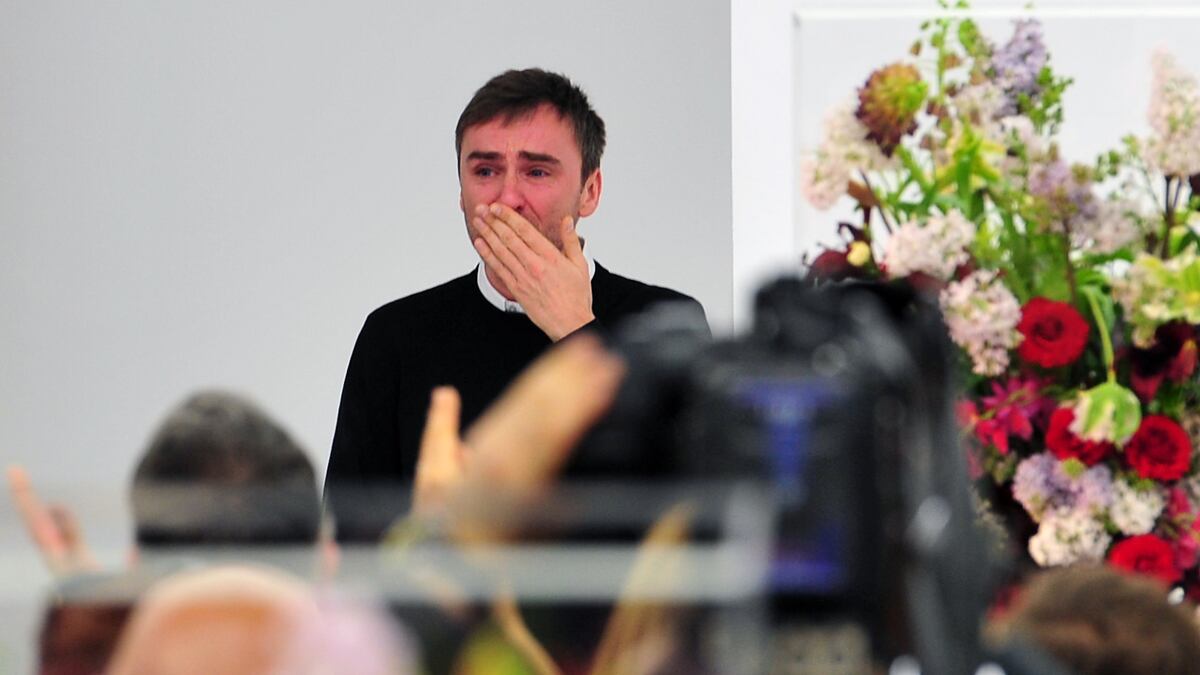
The fashion houses of Milan and Paris are in a state of upheaval—and awash in unconfirmed reports of major shifts in creative leadership. Raf Simons showed his last collection at Jil Sander Saturday afternoon. And the house’s namesake returns to take the creative reins Tuesday. This news was followed by a report later that evening in Women’s Wear Daily that menswear designer–turned–photographer Hedi Slimane would soon be taking over at Yves Saint Laurent, and its current designer Stefano Pilati would be leaving.
All of this shifting about was sparked, of course, by the firing of designer John Galliano last year from his position at Christian Dior. Simons has been rumored to be in contention to replace him. (Dior had no comment.) At the moment, Dior is under the temporary direction of Bill Gaytten, Galliano’s former assistant.
Whenever a major house begins looking for a new designer, there is enormous speculation about who might be on the shortlist. And the top spot at Christian Dior is a significant opportunity. But the fact that it seems to have set off a chain reaction of house hopping by top designers makes one wonder why, in this instance, there doesn’t seem to be a deep store of talent within each house from which the brands can draw—or are willing to draw. It also makes one wonder whether fashion companies, now answerable to impatient shareholders, can no longer afford to wait while designers find their voice.
During the height of the corporatization of the fashion industry, when Gucci Group (now PPR Luxury Group) and LVMH Moët Hennessy Louis Vuitton were in the throes of a battle royal for dominance in the industry, LVMH chief Bernard Arnault touted—as one of the explanations for his success—his patience. He told me that, unlike him, most investors in the luxury business were not willing to wait for a brand to grow and develop. They didn’t understand that it can take a decade—maybe longer—for a brand to find its way. Consider that a company such as Michael Kors, which can now boast that it’s a billion-dollar label, weathered bankruptcy, lackluster sales, and other financial assaults over the course of more than 20 years. It took close to 10 years before Gucci was transformed from a tattered leather-goods house that could barely make payroll into a billion-dollar fashion behemoth. And Arnault spent more than 20 years nurturing the Christian Lacroix label before he finally surrendered and sold it.
Pilati became artistic director of Saint Laurent in 2004. After some eight years, the company—part of PPR Luxury Group—seems to be swinging in the right direction. Its 2011 revenue was up by about 31 percent. No matter. Pilati has been dogged by rumors of his imminent departure practically since his arrival.
Yves Saint Laurent confirmed his departure following his final womenswear collection, which will be presented in Paris March 5.
"We are all at Yves Saint Laurent grateful to Stefano for his important achievements in advancing the mission and success of this historic and treasured fashion house," Yves Saint Laurent Chief Executive Officer Paul Deneve said in a statement.
Pilati become creative director at Saint Laurent after working under Tom Ford. He is an example of what used to be more the norm: the junior designer being promoted to the top spot. At Balmain last year, what now seems like a rarity: Olivier Rousteing succeeded Christophe Decarnin. It’s been a handful of years since Maria Grazia Chiuri and Pier Paolo Piccioli emerged from the backroom shadows to take over at Valentino. It was 11 years ago that Phoebe Philo followed Stella McCartney at Chloé. Near the same time, Francisco Costa stepped up at Calvin Klein. Donna Karan took over at Anne Klein following the death of the label’s namesake in 1974. And going back even further in fashion history, to the 1950s, Yves Saint Laurent stepped into the shoes of Christian Dior.
Even now, while Gaytten has served as interim designer at Dior, the company’s revenue has seen double-digit growth. But today the industry assumes—seems to practically demand—that a star be poached from another top house to fill the job on a permanent basis. It may be that direct lines of succession are less common because talented younger designers want to launch their own brands; they don’t want to wait for their boss to retire or move on. They want to build their own company. Or perhaps it’s because independent family-owned brands are rare, and the ability of a parent to pass the design reins to a child—as with the Missonis—is almost extinct. Corporations are unsentimental and interested not in lineage and sweet traditions—only buzz and profits.
It may be that this is a blip in fashion headhunting. (After all, Gaytten did get promoted to design director at the John Galliano brand.)
“Talent is talent. There’s great talent out there, but for these big jobs it’s always hard to find that level of talent that can handle them,” said Mark Lee, CEO of Barneys New York, who formerly served as top executive at both Gucci and Saint Laurent. In such rarified air, sometimes the talent simply can’t be found within a company, Lee noted. Although, at both his former brands, promotions came from within.
In the meantime, the fashion industry's assumption that no rising, homegrown talent need apply for these top jobs and that massive success can happen in a few years makes it seem not only flaky and dyspeptic, but also uninspiring.





